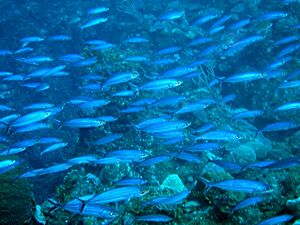Boga facts for kids
Quick facts for kids Boga |
|
|---|---|
 |
|
| A shoal of boga off the coast of Cuba. | |
| Conservation status | |
| Scientific classification | |
| Synonyms | |
|
The Haemulon vittatum, often called the boga, is a type of fish that lives in the ocean. You can find it in the western part of the Atlantic Ocean. People in Jamaica sometimes call it the snit, and in the Bahamas, it's known as the bonnetmouth. A Cuban zoologist named Felipe Poey was the first to describe this fish. It used to have a different scientific name, Inermia vittata, but scientists later found out it belongs to the Haemulon family.
Contents
About the Boga Fish
The boga fish has a body shape like a spindle, which means it's wider in the middle and tapers at both ends. It has a tail fin, called a caudal fin, that is deeply forked, like a "V" shape. Its two fins on its back, called dorsal fins, are very close to each other.
One special thing about the boga is its mouth. It can push its mouth out much further than many other fish. This is why it's sometimes called the bonnetmouth. Boga fish usually have 14 or 15 stiff spines on their dorsal fins, but only 10 soft rays. They also have two spines and nine rays on their anal fins, which are located on their underside. The longest boga ever recorded was about 23 centimeters (about 9 inches) long.
Boga's Colors
When a boga is alive, its colors are usually greenish on top and bluish-white underneath. You can often see a greenish stripe, with a hint of yellow, running from its eye all the way to its tail. It also has three similar stripes on its back. The front part of its head and its dorsal fins are yellowish or pale yellow. Its tail fin is a dark violet color. The fins on its sides, called pectoral fins, are rosy, while its anal and ventral fins are white.
Where Bogas Live and What They Eat
The Haemulon vittatum is only found in the western Atlantic Ocean. This area stretches from Florida and the Bahamas south to the northern parts of South America. It also includes the Antilles and the Caribbean Sea.
Boga Habitats
Bogas live in open water. Sometimes, you might find them close to coasts or near coral reefs. However, they are mostly found off the shores of islands in the ocean.
Boga's Diet and Predators
These fish mainly eat tiny ocean creatures called zooplankton, as well as smaller fish. People sometimes catch bogas to sell them fresh or use them as baitfish for other fishing. Larger fish, like the red hind (Epinephelus guttatus), which is a type of grouper, are known to hunt and eat bogas.
How the Boga Got Its Name
The Haemulon vittatum was first officially described in 1860. It was given the name Inermia vittata by a Cuban zoologist named Felipe Poey (who lived from 1799 to 1891). The place where it was first studied was Havana, Cuba.
The scientific name vittatum means "banded." This name likely refers to the wide greenish stripe that runs from the boga's eye to the base of its tail fin. It also refers to the three or four brownish stripes found above that main stripe on its body.
See also
 In Spanish: Boga para niños
In Spanish: Boga para niños



